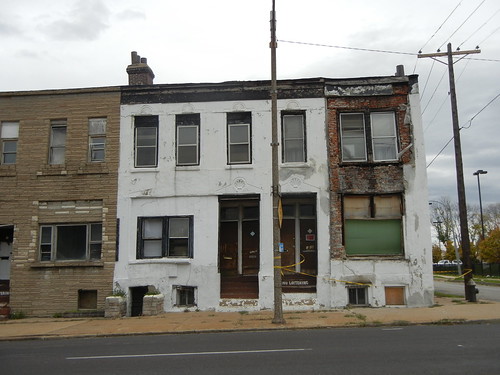by Michael R. Allen
In The Power of Place, Dolores Hayden champions the study and preservation of common urban vernacular housing as the best way to record the lives of most Americans. “Most can be learned from urban building types that the represent the conditions of thousands or millions of people,” Hayden writes. Yet Hayden finds that scholars are more interested in simpler rural and exotic urban types (the mythic flounder house is our local intrigue-builder). To some scholars, Hayden observes, “the best vernacular building will always be the purest, the best preserved or the most elaborate example of its physical type.”
Hayden’s observations can be counterbalanced by emergent material culture studies that widen the architectural history of cities beyond the showiest (prettiest?) vernacular buildings and those whose owners seek official landmark or National Register status (regulatory vehicles that enhance but do not replace cultural appreciation). Objectification of domestic architecture is far simpler using pure examples — we who practice architectural history can then shift the focus onto style, form and material so as to avoid messier discussions of class, race, use, power and alteration. Yet much housing production historically in St. Louis and other cities came through mass building practice. One of those practices was alteration by later, lower-income owners often strapped for cash and in search of a cheap fix.

Take for example the stone-faced, bright-white-painted, two-story tenement at 1426-1428 North Grand Boulevard. Today the building sports a missing section of facade that is due to a common mass repair — the application of mortar to cover failing stonework. Known as “parging,” this practice can be seen on houses built for middle and working class St. Louisans. These buildings, built between 1860 and 1890, often utilized softer sandstone facing in place of more expensive limestone or granite. Common local sandstone sources were Warrensburg, Missouri, from which came a blue stone, and Iowa, from which came a red stone. Both stones are susceptible to damage in St. Louis weather, especially if tuckpointed with mortars using Portland cement (common after around 1910).
Other repairs include widow replacement (not quite the right fit!) and cornice removal. Still, this four-family building is graceful if not very spectacular for its date of construction, which would be the early 1870s (building permit research pending). The incised ornament in the stone front is hand-carved and lovely, but common enough in that time even for St. Louis. What might make this building lapse into the rarefied lists of significant buildings is that the majority of other simple flat-roofed stone-faced tenements of this time in north city have been demolished.

Next door, to the north, is a similar building showing another vernacular repair: the PermaStone cladding common in the 1950s and 1960s, on the right half. The left half has brick. The two fixes alter the number of windows and the size of openings, but the essential building is clearly nearly identical to its neighbor. Who knows what lies beneath the cladding? Most owners who would have been thrifty would have affixed that cladding over the facade. Hence there may be a sister building here.
These houses would have been built by European-Americans (probably German or Irish) but would have been occupied by African-Americans in this area by 1930. In 1966, this area became known as “JeffVanderLou” and was the scene of African-American historic preservation activism led by Macler Shepard. To Shepard, houses were stores of community wealth and modes of resistance against urban renewal clearance. Today, the house and its human-scaled neighbors seem to be a modest testament to the work and will of the visionary Shepard, who died in 2005.

Today, the vernacular stone-faced house on North Grand needs repairs again. Hopefully the current owners do something to enhance what has been damaged, rather than remove the remains of the original stone face. The stone looks to be fully fixable, and replication might not be cost prohibitive. Yet the building won’t receive incentives for anything its owners do, since it is not within an official historic district and is within the Northside Regeneration LLC redevelopment area that the city seeks to uphold even amid a Supreme Court hearing next month.
No matter what the fix, this building tells stories about this city’s building traditions, and about the efforts of successive owners to keep it standing. Whether it ever gets full restoration or lands within a historic district, it ought to be standing as long as someone wants to live in it.

2 replies on “As Long As Someone Wants to Live in It”
I’ve always loved those buildings. Thanks for bringing them to the forefront.
Hopefully these will survive. The City condemned not just the corner, but both halves of the white four family for demolition on the 2nd of this month.